Impact Modifier Market Size
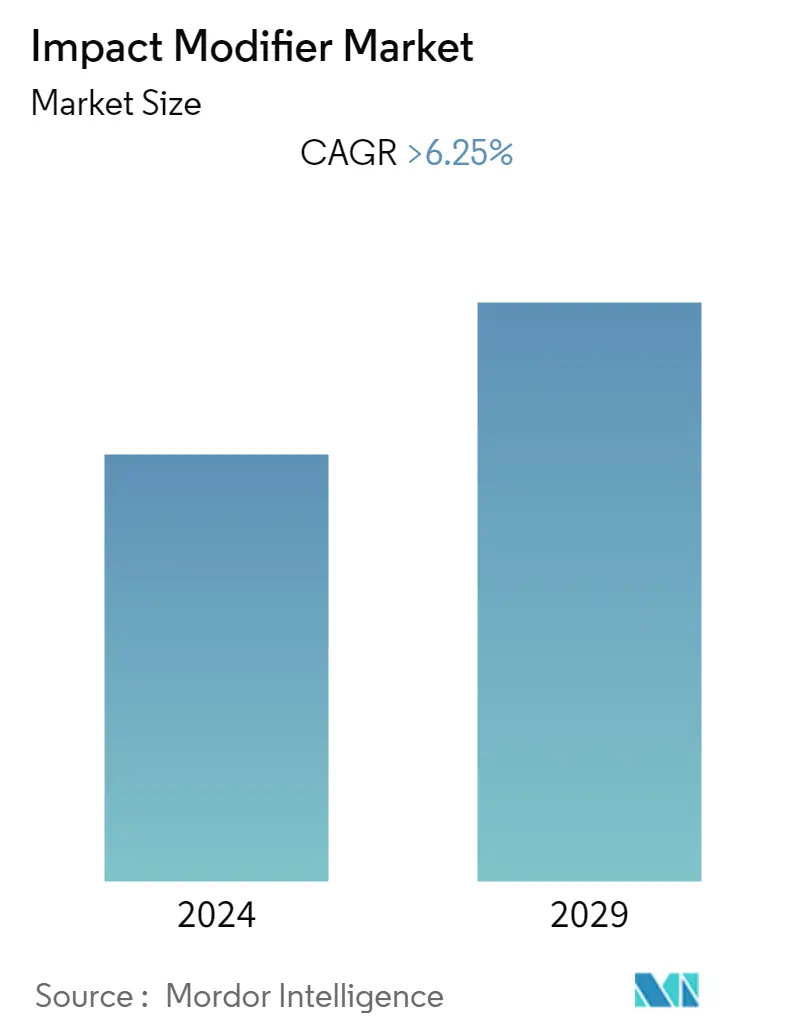
| Study Period | 2019 - 2029 |
| Base Year For Estimation | 2023 |
| CAGR | 6.25 % |
| Fastest Growing Market | Asia Pacific |
| Largest Market | Asia Pacific |
| Market Concentration | Low |
Major Players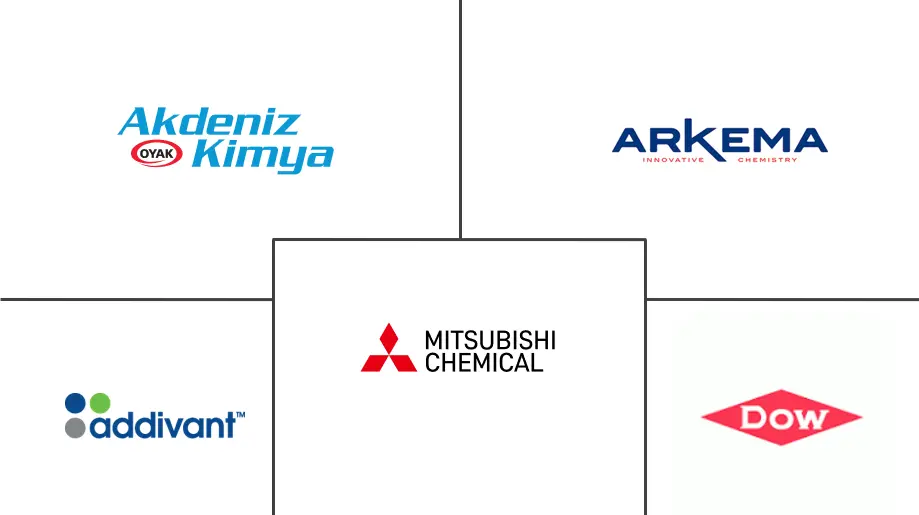
*Disclaimer: Major Players sorted in no particular order |
Impact Modifier Market Analysis
The Impact Modifier Market is expected to register a CAGR of more than 6.25% during the forecast period.
The impact of the COVID-19 pandemic was negative as the major end-user industries of the market were shut, such as construction and automotive. But by 2021, the market had returned to where it was before the pandemic, and it is expected to grow steadily over the next few years.
- The growing demand from the PVC segment and packaging industry has been driving market growth.
- However, environmental regulations on using certain compounds to produce impact modifiers hinder the market.
- The technological advancements in impact modifiers for rubber and sustainable bioplastic packaging are expected to provide opportunities for the impact modifier market over the next five years.
- Asia-Pacific dominated the global market, with the largest consumption in countries such as China and India.
Impact Modifier Market Trends
Increasing Demand from the Construction Industry
- Impact modifiers are building chemicals that improve plastic goods' toughness and longevity, such as pipelines, siding, and roofing materials. They are added to plastic during production to increase its resilience to impact, weathering, and other forms of stress.
- Acrylic impact modifiers and MBS modifiers are used in the construction sector to improve PVC and ABS's toughness, impact resistance, and weather ability.
- Impact modifiers for polyethylene (PE) are used in polyolefin applications to improve the plastic's impact resistance and durability. Impact modifiers for styrenic block copolymers (SBC) are extensively used in the construction industry for roofing and siding applications to improve the plastic's impact resistance and longevity.
- PVC pipelines are extensively used in plumbing and drainage systems, so their demand is strongly correlated with the expansion of the construction industry, particularly in the residential sector. As more homes and structures require plumbing and drainage systems, an increase in residential construction can increase the demand for PVC pipelines.
- Recent years have seen a significant increase in residential construction in the United States, particularly in certain regions. The number of housing units authorized by building permits was 1.74 million in 2021, an increase of 18% from the previous year, according to data from the U.S. Census Bureau.
- Canada's residential and commercial construction industries are experiencing strong demand. Statistics Canada projects that by the end of 2022, 135.36 million permits will have been issued, a 6.2% increase from the previous year.
- The construction industry is expected to dominate the market based on the factors above.
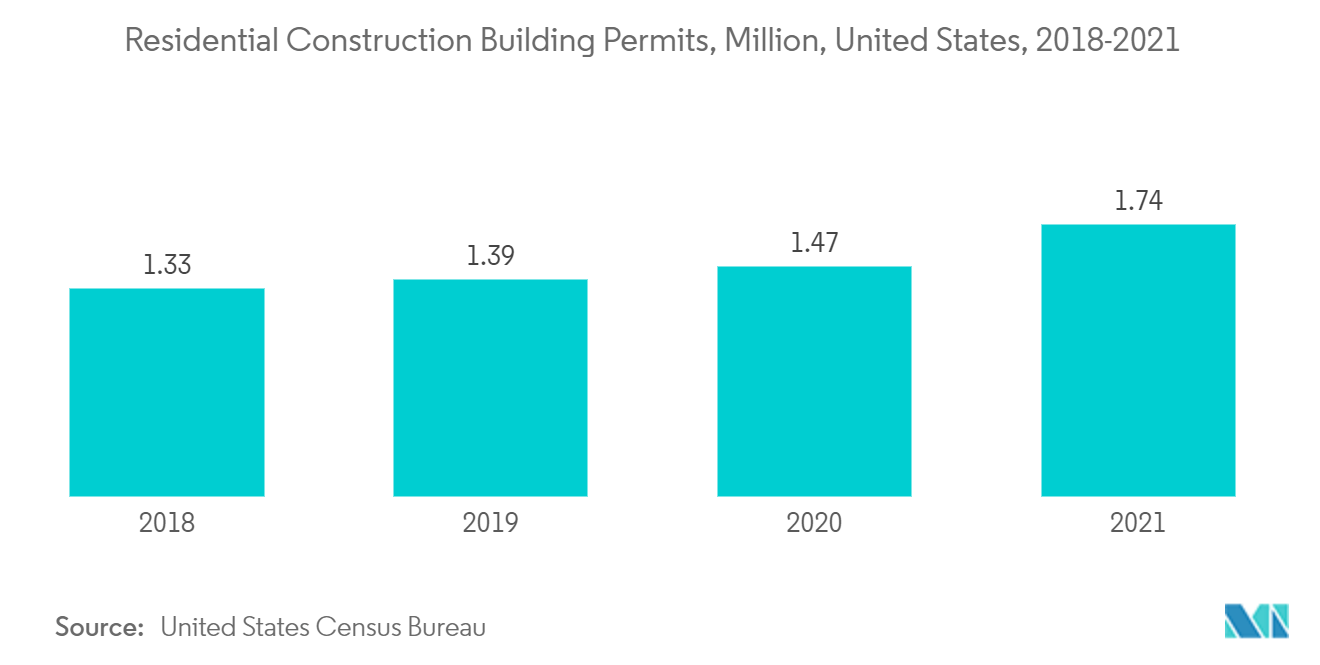
Asia-Pacific Region to Dominate the Market
- The Asia-Pacific region is the largest and fastest-growing market because of the increasing demand for polymer products in various end-user industries in major economies such as China, India, and Japan.
- Plastics manufacture interior and exterior parts of automobiles, such as door panels, instrument panels, consoles, pillars, door panel skin, window seals, and body side cladding. Growing awareness regarding energy efficiency, lightweight, and the popularity of electric vehicles is anticipated to boost the market growth.
- Asia is the largest producer and consumer of plastics in the world. Moreover, the region manufactures approximately 50% of the world's automotive, with established manufacturing facilities in China, Japan, India, South Korea, and Thailand.
- The plastic casing or housing of battery cells used in electric automobiles contains impact modifiers. The battery enclosure is a crucial component that protects the cells from impacts, vibrations, and other mechanical stress that could cause the battery to degrade or perform poorly.
- To increase the battery housing's resistance to impact, manufacturers may add impact modifiers to the plastic material used to construct the housing. These impact modifiers may consist of elastomers, toughening agents, or other additives that increase the plastic's strength and durability.
- According to the China Association of Automobile Manufacturers (CAAM), 47 Chinese power battery manufacturers produced 186,0 GWh in 2021, a year-over-year increase of 182.3%. The production increase was predominantly attributable to China's accelerated expansion of new energy vehicles. (NEVs). In 2021, China will have produced 4.71 million NEVs, with domestic sales exceeding 1.5 million units, a year-over-year increase of over 80%: government policies, subsidies, and consumer demand for NEVsfueled this expansion.
- Impact modifiers are also utilized in the production of mobile phones to increase the device's durability and resistance to impact. In 2022, Chain will be the world's largest producer of mobile devices, accounting for more than 30 percent of global output. China's mobile phone manufacturing capacity is expected to exceed 1.5 billion units by 2022, according to the China Academy of Information and Communications Technology, while domestic mobile phone shipments will reach 354.7 million units in 2021.
- Hence, the Asia-Pacific region is expected to dominate the market based on such market trends.
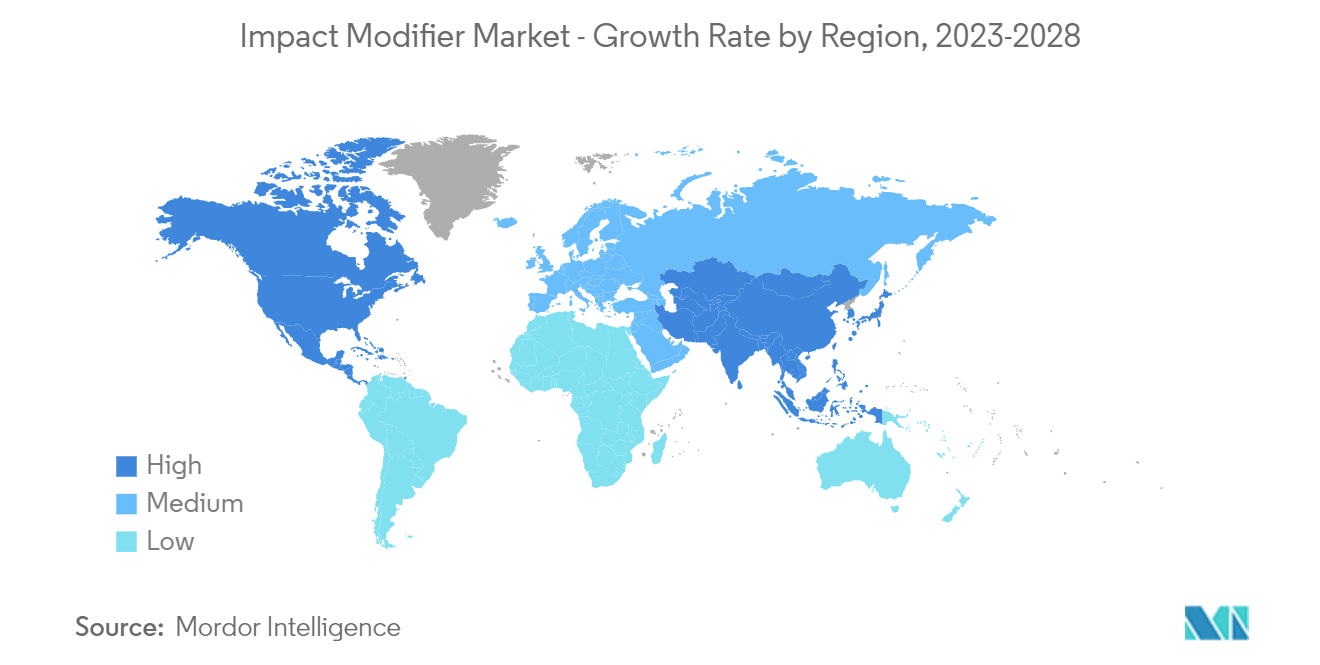
Impact Modifier Industry Overview
The Impact Modifier Market is fragmented in nature, with a few major players dominating a significant portion of the market. Some of the major companies (in no particular order) are Mitsubishi Chemical Corporation, Akdeniz Kimya, Arkema Group, Addivant, and Dow.
Impact Modifier Market Leaders
-
Mitsubishi Chemical Corporation.
-
Arkema Group
-
Addivant
-
Dow
-
Akdeniz Chemson
*Disclaimer: Major Players sorted in no particular order
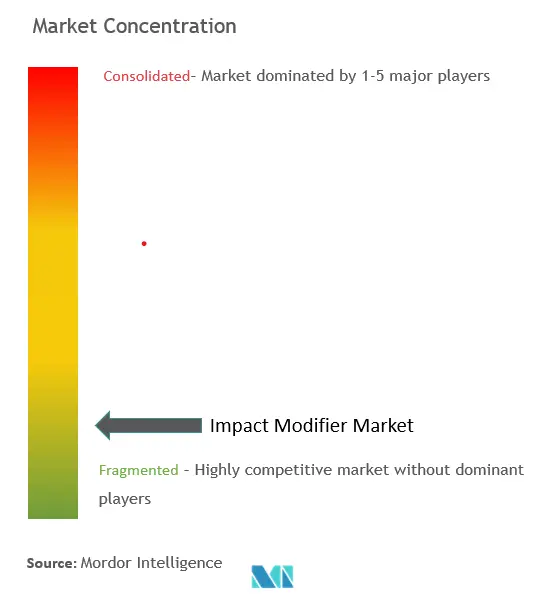
Impact Modifier Market News
- Recent developments pertaining to the market studied will be covered in the full report.
Impact Modifier Market Report - Table of Contents
1. INTRODUCTION
- 1.1 Study Assumptions
- 1.2 Scope of the Study
2. RESEARCH METHODOLOGY
3. EXECUTIVE SUMMARY
4. MARKET DYNAMICS
-
4.1 Drivers
- 4.1.1 Growing Packaging Industry
- 4.1.2 Increasing Demand from the PVC Segment
-
4.2 Restraints
- 4.2.1 Other Restraints
- 4.3 Industry Value Chain Analysis
-
4.4 Porter's Five Forces Analysis
- 4.4.1 Bargaining Power of Suppliers
- 4.4.2 Bargaining Power of Buyers
- 4.4.3 Threat of New Entrants
- 4.4.4 Threat of Substitute Products
- 4.4.5 Degree of Competition
5. MARKET SEGMENTATION (Market Size in Value and Volume)
-
5.1 Type
- 5.1.1 Acrylonitrile Butadiene Styrene (ABS)
- 5.1.2 Acrylic Impact Modifiers (AIM)
- 5.1.3 Acrylonitrile Styrene Acrylate (ASA)
- 5.1.4 Methacrylate-Butadiene- Styrene (MBS)
- 5.1.5 Ethylene Propylene Diene Monomer (EPDM)
- 5.1.6 Chlorinated Polyethylene (CPE)
- 5.1.7 Other Types
-
5.2 Application
- 5.2.1 Polyvinyl Chloride (PVC)
- 5.2.2 Nylon
- 5.2.3 Polybutylene Terephthalate (PBT)
- 5.2.4 Engineering Plastics
- 5.2.5 Other Applications
-
5.3 End-user Industry
- 5.3.1 Packaging
- 5.3.2 Construction
- 5.3.3 Automotive
- 5.3.4 Consumer Goods
- 5.3.5 Other End-user Industries
-
5.4 Geography
- 5.4.1 Asia-Pacific
- 5.4.1.1 China
- 5.4.1.2 India
- 5.4.1.3 Japan
- 5.4.1.4 South Korea
- 5.4.1.5 Rest of Asia-Pacific
- 5.4.2 North America
- 5.4.2.1 United States
- 5.4.2.2 Canada
- 5.4.2.3 Mexico
- 5.4.3 Europe
- 5.4.3.1 Germany
- 5.4.3.2 United Kingdom
- 5.4.3.3 France
- 5.4.3.4 Italy
- 5.4.3.5 Rest of Europe
- 5.4.4 South America
- 5.4.4.1 Brazil
- 5.4.4.2 Argentina
- 5.4.4.3 Rest of South America
- 5.4.5 Middle East & Africa
- 5.4.5.1 Saudi Arabia
- 5.4.5.2 South Africa
- 5.4.5.3 Rest of Middle East & Africa
6. COMPETITIVE LANDSCAPE
- 6.1 Mergers and Acquisitions, Joint Ventures, Collaborations, and Agreements
- 6.2 Market Share (%) Analysis **/ Market Ranking Analysis
- 6.3 Strategies Adopted by Leading Players
-
6.4 Company Profiles
- 6.4.1 Addivant
- 6.4.2 Akdeniz Kimya
- 6.4.3 Arkema Group
- 6.4.4 Clariant
- 6.4.5 Dow
- 6.4.6 Evonik Industries AG
- 6.4.7 Kaneka Americas Holding Inc.
- 6.4.8 Mitsubishi Chemical Corporation
- 6.4.9 Plastics Color Corporation
- 6.4.10 Shandong Ruifeng Chemical Co. Ltd
- *List Not Exhaustive
7. MARKET OPPORTUNITIES AND FUTURE TRENDS
- 7.1 Technological Advancements in Rubber and Sustainable Bio-packaging
Impact Modifier Industry Segmentation
Impact modifier resins increase the durability of molded and extruded plastics, especially for impact strength or cold weather services. They are important supplements added for increasing elasticity to overcome the rigidity of materials.
The Impact Modifier Market is segmented by type, application, and end-user industry. By type, the market is segmented into acrylonitrile butadiene styrene, acrylic impact modifiers, acrylonitrile styrene acrylate, methacrylate-butadiene-styrene, ethylene propylene diene monomer, chlorinated polyethylene, other types. By application, the market is segmented into polyvinyl chloride, nylon, polybutylene terephthalate, engineering plastics, and other applications. By end-user industry, the market is segmented into automotive, construction, consumer goods, packaging, and other end-user industries. The report also covers the market size and forecasts for the impact modifier market in 15 countries across major regions. For each segment, the market sizing and forecasts have been done on the basis of revenue (USD million) and volume (kilotons).
| Type | Acrylonitrile Butadiene Styrene (ABS) | |
| Acrylic Impact Modifiers (AIM) | ||
| Acrylonitrile Styrene Acrylate (ASA) | ||
| Methacrylate-Butadiene- Styrene (MBS) | ||
| Ethylene Propylene Diene Monomer (EPDM) | ||
| Chlorinated Polyethylene (CPE) | ||
| Other Types | ||
| Application | Polyvinyl Chloride (PVC) | |
| Nylon | ||
| Polybutylene Terephthalate (PBT) | ||
| Engineering Plastics | ||
| Other Applications | ||
| End-user Industry | Packaging | |
| Construction | ||
| Automotive | ||
| Consumer Goods | ||
| Other End-user Industries | ||
| Geography | Asia-Pacific | China |
| India | ||
| Japan | ||
| South Korea | ||
| Rest of Asia-Pacific | ||
| Geography | North America | United States |
| Canada | ||
| Mexico | ||
| Geography | Europe | Germany |
| United Kingdom | ||
| France | ||
| Italy | ||
| Rest of Europe | ||
| Geography | South America | Brazil |
| Argentina | ||
| Rest of South America | ||
| Geography | Middle East & Africa | Saudi Arabia |
| South Africa | ||
| Rest of Middle East & Africa |
Impact Modifier Market Research FAQs
What is the current Impact Modifier Market size?
The Impact Modifier Market is projected to register a CAGR of greater than 6.25% during the forecast period (2024-2029)
Who are the key players in Impact Modifier Market?
Mitsubishi Chemical Corporation., Arkema Group, Addivant, Dow and Akdeniz Chemson are the major companies operating in the Impact Modifier Market.
Which is the fastest growing region in Impact Modifier Market?
Asia Pacific is estimated to grow at the highest CAGR over the forecast period (2024-2029).
Which region has the biggest share in Impact Modifier Market?
In 2024, the Asia Pacific accounts for the largest market share in Impact Modifier Market.
What years does this Impact Modifier Market cover?
The report covers the Impact Modifier Market historical market size for years: 2019, 2020, 2021, 2022 and 2023. The report also forecasts the Impact Modifier Market size for years: 2024, 2025, 2026, 2027, 2028 and 2029.
Impact Modifier Industry Report
The Impact Modifier Market report provides a comprehensive industry overview and market analysis. It covers various segments by type, application, end-user industry, and geography. The report includes detailed industry information and industry statistics, offering insights into market growth and market trends.
The market forecast and market outlook are based on thorough industry research and market data, providing a clear picture of the market segmentation and market value. The report highlights the growth rate of different segments and identifies market leaders in the industry.
This industry report also includes a market review and market predictions, ensuring that stakeholders have access to accurate and up-to-date market information. The report example and report pdf are available for further reference, offering a detailed industry analysis and market overview.
The industry reports and industry research provide a solid foundation for understanding the market size and market growth. The industry outlook and market forecast are essential for making informed decisions. The report also includes insights into industry sales and market segmentation, ensuring a comprehensive understanding of the market dynamics.
Overall, this report is an invaluable resource for anyone looking to gain a deeper understanding of the Impact Modifier Market, with detailed industry trends and market data to guide strategic planning and decision-making.



